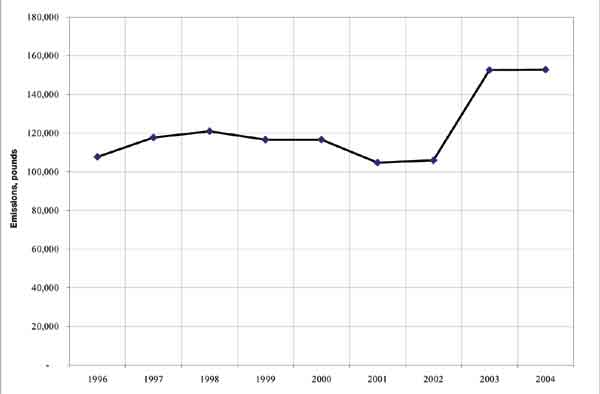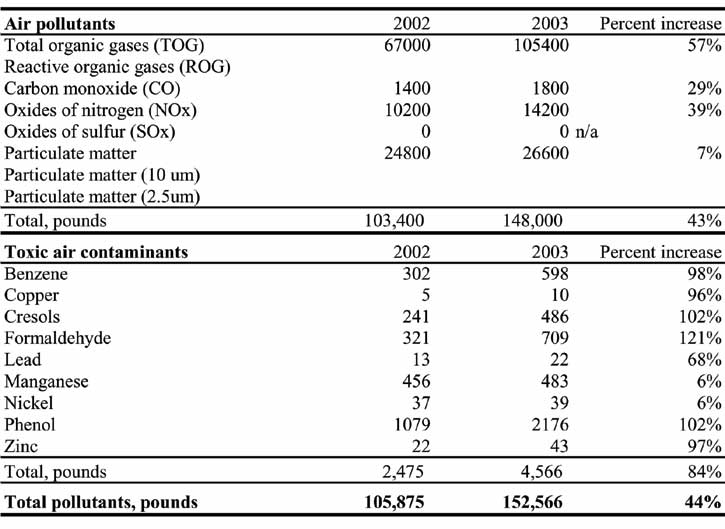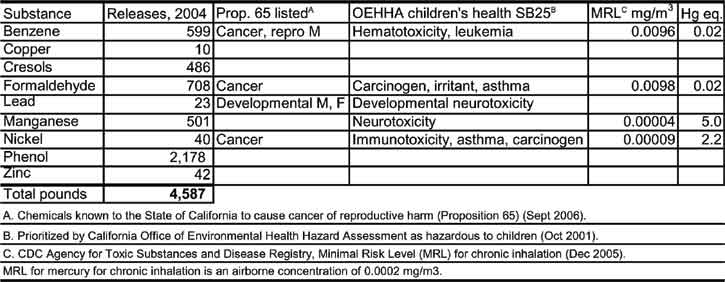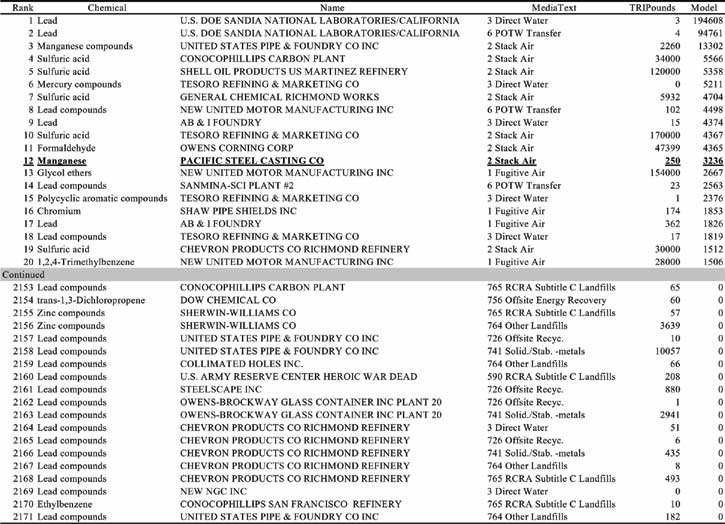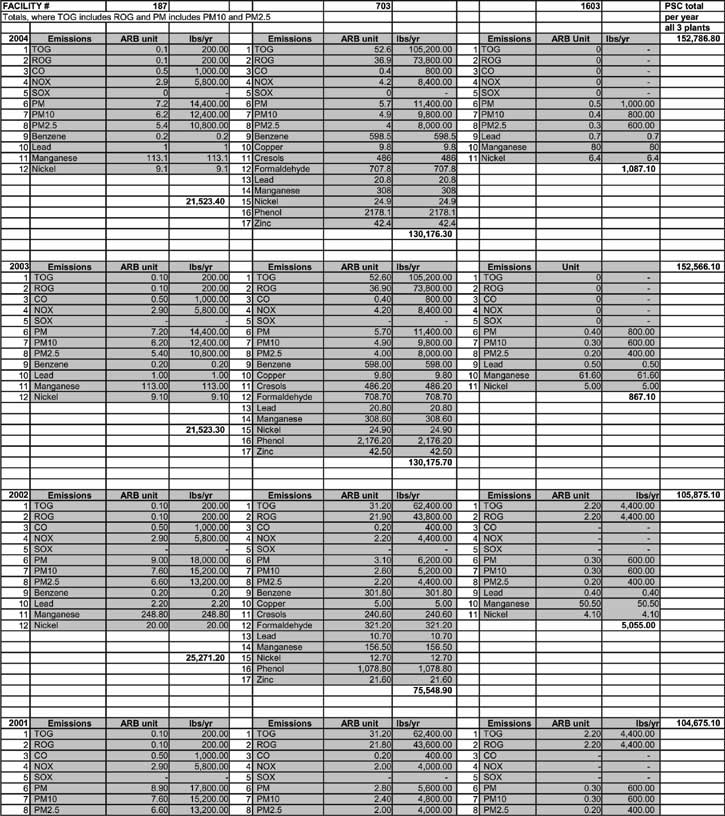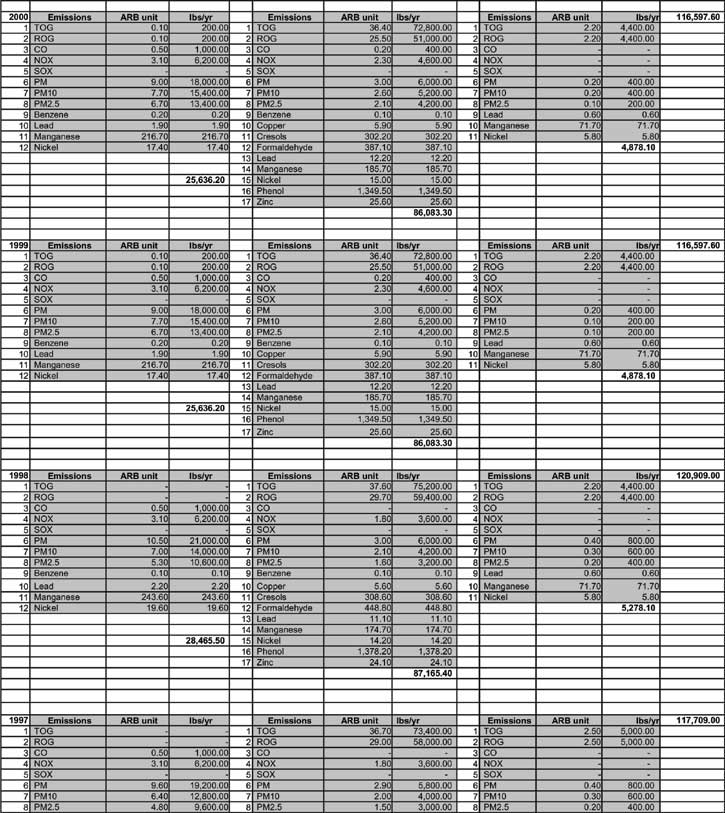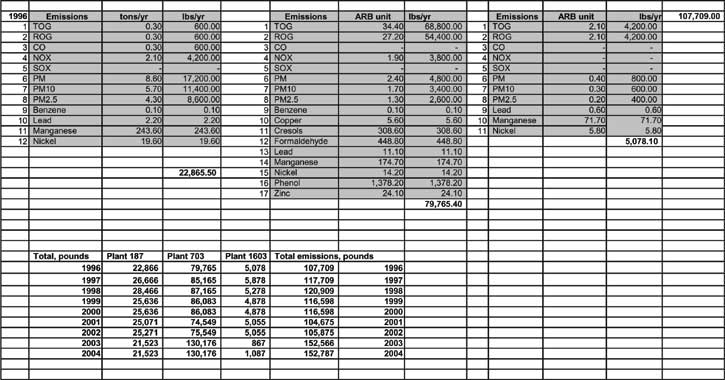
Continuing Assessment of Pacific Steel Casting, Berkeley, California
Michael P. Wilson, Ph.D, MPH Assistant Research Scientist Center for Occupational and Environmental Health School of Public Health University of California, Berkeley, California
October 18, 2006
|
Continuing Assessment of Pacific Steel Casting, Berkeley, California
PSC faces two key problems that, on the current trajectory, are likely to worsen over time. These are the public health implications of the plant's emissions and the fact that these emissions (particularly in light of increases in recent years) are inconsistent with the west Berkeley plan and Berkeley's Sustainable Development Initiative.
1. There is evidence that PSC is emitting a substantial quantity of toxic materials into densely populated areas of Berkeley and surrounding communities.
A. In data reported by PSC to the Bay Area Air Quality Management District (BAAQMD), total emissions of toxic air contaminants and criteria air pollutants from the plant increased 44% between 2002 to 2003, from 105,875 pounds in 2002 to 152,566 pounds in 2003 (Figure 1). In 2004, PSC reported high emissions similar to the 2003.
B. According to data posted by the California Air Resources Board, between 2002 and 2003 emissions of air pollutants increased 43%, while emissions of toxic air contaminants increased 84% (Table 1).
Table 1. Total pounds of criteria air pollutants and toxic air contaminants emitted from Pacific Steel Casting plants 187, 703 and 1603 for 2002 and 2003.
2. Children are uniquely vulnerable to the effects of chemical exposures.
In 1993, the National Academy of Sciences reported that children are uniquely vulnerable to the effects of chemical exposures during all periods of fetal, infant, and child development. [2] This vulnerability is attributable to four key factors, as follows:
• Sensitive physiological processes can be disrupted during the rapid growth and development characteristic of embryonic and fetal life and the first year following birth. Development of the brain, for example, requires the formation and interconnection of billions of neurological cells; development of the endocrine system and reproductive organs is guided by a precisely timed sequence of hormones that exert their effects in the parts-per-trillion range.
• Children's metabolic pathways, especially in fetal life and in the first month after birth, are immature. Among other factors, growth of the blood-brain barrier, which can provide protection against some chemicals, is incomplete during fetal and early child development, such that chemicals are able to move directly from the maternal blood stream into the developing fetal brain.
• Relative to their size, children's intake of air, water, and food is far greater than that of adults. The amount of air a resting infant breathes, for example, is twice that of an adult, normalized by body weight. Children therefore experience disproportionately higher doses of environmental agents, including chemicals.
• Children have more years of future life than adults and thus have more time to develop diseases initiated by exposures early in life. Many chronic diseases, including cancer and neurodegenerative diseases, appear to arise as a result of cellular changes that take place many years before the actual manifestation of the disease. Critical windows of exposure to hazardous chemicals in utero, during early child development, and during puberty are more likely to produce chronic disease than similar exposures encountered later.
3. PSC emissions are of public health significance, particularly to children's health.
The air contaminants reported by PSC to the BAAQMD consist of substances that have been targeted in the U.S. and California for tracking and emission reductions because they are known to be toxic to humans; even at low exposure levels, they pose a hazard to health. In the case of PSC, these emissions consist of a number of highly toxic heavy metals that persist in the environment, accumulate in human tissues, and are uniquely hazardous to children. In 2004, PSC emitted 1,370 pounds of substances known by the State of California to cause cancer or reproductive harm (Prop 65), along with 1,871 pounds of substances that are listed in the top 17 of 200 Toxic Air Contaminants considered to be of unique concern for children's health by Cal/EPA's Office of Environmental Health Hazard Assessment (OEHHA) (Figure 2).
Manganese, lead, and nickel are toxic to the human neurological system, they are hazardous to fetal development, and/or they produce a range of other toxic effects. The chronic inhalation Minimal Risk Level (MRL) for manganese established by the Agency for Toxic Substances and Disease Registry of the CDC is 0.00004 mg/m3 for community exposures, as a continuous 24-hour time-weighted average, with a disease endpoint of neurotoxicity.[3] The inhalation Minimal Risk Level for mercury is 0.0002 mg/m3. The long-term risk of neurological disease resulting from inhalation exposures is therefore considered by ATSDR to be about five times higher for manganese, when compared with mercury (Figure 2). The chronic inhalation MRL for nickel is 0.00009 mg/m3. There is no safe level of exposure to lead for children.[4] Dispersing these substances into densely populated urban areas is inherently problematic for public health, particularly for children, and should be corrected immediately.
4. There is evidence of surface contamination by heavy metals in areas of Berkeley in the vicinity of PSC.
An analysis conducted by an analytical laboratory of 6 wipe samples taken from surfaces in areas in the vicinity of PSC show evidence of heavy metal contamination. These metals are most likely coming from industrial, not mobile, sources. Five of the eight metals identified in the samples are emitted by PSC. These metals are associated with health hazards of various types (Figure 2). The only existing health-based standards for wipe samples are those of U.S. EPA's indoor monitoring program for post-911 areas of New York, which are based on ingestion. Two of the Berkeley samples markedly exceed this standard for lead. This analysis will require further sampling; it suggests, however, that toxic heavy metals are settling out of air into these areas of Berkeley. The City of Berkeley will need explore a vehicle for eliminating all discharges of heavy metals by industry and businesses, including by PSC.
5. By its emissions of manganese alone, PSC was ranked #12 for public health risk among 2,171 stationary sources in six Bay Area counties by US EPA.
According to risk screening estimates by U.S. EPA, PSC is in the top 1% of stationary sources for risks to public health in six Bay Area counties (Figure 4). EPA arrived at this estimate based on PSC's emissions of manganese alone; the estimate did not take into account the plant's emissions of other toxic metals (lead, nickel etc), air toxics (benzene, formaldehyde etc) and criteria air pollutants. The estimate was also based on an emission mass of only 250 pounds of manganese per year, not the 500 pounds reported by PSC to BAAQMD in 2004. According to EPA staff, this risk rating is based on the toxicity of manganese, the quantity of manganese emitted, the prevailing wind at the plant site, and the characteristics of the exposed population (e.g. population density, proximity to the emission source, etc).[5]
5. PSC's emission control plan for Plant #3 will not be sufficient to address emissions of toxic materials from this plant or those from Plants #1 and #2.
PSC is installing pollution controls that are intended to capture phenol and other vapors from Plant #3. These vapors are the likely source of noxious odors experienced by residents of Berkeley and surrounding areas. This control technology could produce reductions in these emissions, but it is not likely to capture growing quantities of metals and particulates emitted by the plant.
6. The emissions of toxic materials from PSC appear to be at odds with the City's emphasis on linking environmental protection with economic growth.
The West Berkeley Plan calls for economic growth linked with sound environmental performance: [6]
"The West Berkeley Plan should help make it possible for all sectors to--in an environmentally sound manner--continue to thrive. Some sectors will play their most important role in the creation of good jobs, particularly for those with poor employment prospects, others in supplying a wide and innovative range of goods and services, perhaps still others in increasing the City's tax revenue. The Plan recognizes that the widespread view of (West) Berkeley as a clean, environmental area is an economic as well as an environmental advantage."[7]
With increasing emissions of criteria air pollutants and toxic air contaminants, PSC is operating under conditions that are environmentally unsustainable; this path is inconsistent with the West Berkeley Plan and it undermines the positive intent of the Plan.
PSC' s environmental performance also appears to be inconsistent with the City of Berkeley's Sustainable Development Initiative [8, 9]
"Long a leader in social and environmental issues, the City of Berkeley promotes a sustainable economy by combining environmental protection with economic growth. Berkeley encourages companies to provide goods or services that enhance the environment, conserve resources or prevent pollution, and exemplify environmental leadership."
Finally, PSC's environmental performance appears to be at odds with the mission statement of the West Berkeley Association of Industrial Companies (WeBAIC)[10]
"We are dedicated to promoting an environment in West Berkeley in which manufacturers, distributors and artisans can flourish and develop sustainable industries."
7. A lack of trust has developed between Berkeley residents and PSC.
During the last several years, over 50 articles and letters to the editor have appeared in Bay Area papers expressing criticism, and dismay, over PSC's emissions of noxious odors.[11] This record represents not simply a series of isolated events but rather a general pattern of neglect on the part of PSC with respect to its relations with the Berkeley community.
It is likely that a worsening public perception of the plant will occur as residents and workers in Berkeley and surrounding areas become aware of, and frustrated with, emissions of toxic air contaminants from the plant, together with the lack of openness and concern that PSC has exhibited regarding these emissions and the lack of vigorous efforts they have taken to control them.
8. The path forward
Faced with this set of problems, PSC now faces a critical juncture. While the plant has acknowledged its odor problems that are affecting the community, it will now need to do the same for its emissions of criteria air pollutants and toxic air contaminants. There is legitimate concern among residents and workers in Berkeley and surrounding areas over these emissions. The plant should take immediate steps to open communications with the community regarding these emissions and implement a broad strategy to prevent the dispersion of these substances into the community.
In this spirit, I proposed a toxics use reduction strategy in an April 2006 letter to the PSC board by way of the company's PR firm, AJE Partners. That proposal called for a stakeholder working group that would
(1) establish a mechanism to ensure public reporting and accountability,
(2) come to terms with the facts regarding public health problems related to the plant, both real and perceived,
(3) establish cost estimates for correcting these problems,
(4) list and evaluate the set of options for correcting these problems,
(5) identify the set of options that is most amenable to the Working Group, and
(6) solicit PSC Board's support for a chosen set of options. This process was proposed to establish "a set of agreed-upon goals that can then be used as a 'roadmap' for the plant, the community, the PSC workforce, and the City."To date, PSC has not responded to this proposal.
1. California Air Resources Board, Air Toxics "Hot Spots" Information and Assessment Act of 1987 (AB 2588, Connelly) (http://www.arb.ca.gov/ab2588/overview.htm (accessed October 9, 2006) Facility Search Tool for PSC among 10,000 facilities in California, updated by ARB February 27, 2006. http: /www.arb.ca.gov/app/emsinv/facinfo/facinfo.php?dd (http://www.arb.ca.gov/app/emsinv/facinfo/faccrit.php?dd&grpl&sortFacilitvNameA&dbvr2 004&ab SF &dis &co &fname steel&citv berkelev&fzip &fsic &facid &all facC&displavitPollutant&showpol &showpol2 (accessed October 9, 2006).
2. National Academy of Sciences, National Research Council. Pesticides in the Diets of Infants and Children. Washington, D.C.:National Academy Press, 1993.
3. http://www.atsdr.cdc.gov/mrls.html (accessed March 31,2006)
4. hup://www.atsdr.cdc.gov/cabs/lead/lead cabs.pdf
5. U.S. EPA Risk Screening Environmental Indicators (RSEI) (http://epa.gov/oppt/rsei/) (accessed March 29, 2006) (Leif Magnuson, U.S. EPA Region IX, personal communication).
6. The West Berkeley Plan. (http: /www.ci.berkelev.ca.us/planning/landuse/plans/westberkelev/wbtoc.htm(accessed March 29, 2006).
7. The West Berkeley Plan, Economic Development, I. Strategic Statement (http / /www.ci.berkeley.ca.us /planning/landuse/plans/westberkelev/econdev.htm (accessed March 29, 2006).
8. Energy and Sustainable Development, City of Berkeley (http / /www.ci.berkelev.ca.us /sustainable/communitv/definition.html (accessed March 29, 2006). (http / /www.ci.berkeley.ca.us /mayor/ pr/pressrelease2005%2D0602.htm (accessed March 29, 2006).
9. City of Berkeley Annual Report, Winter 2006. The Greening of Berkeley: Berkeley's Sustainable Development Initiative.The number of green businesses in Berkeley now exceeds 200.
10. West Berkeley Association of Industrial Companies. 900 Murray Street, Berkeley CA 94710 510-841-SAVE, Extension 304.
11. Chronology of Pacific Steel Casting, Bay Area Air Quality Management District, and Neighbors for Clean Air/West Berkeley Alliance for Clean Air and Safety Jobs History, 1980-2005.
*************************************************************************************************
Comments of Michael P. Wilson, Ph.D, MPH
Commissioner Community Environmental Advisory Commission
To: Berkeley City Council meeting, March 13, 2007Point 1. The CEAC report notes that PSC publicly reported to the state of California in 2004 that it disposed of 76 tons of toxic air pollution into Berkeley's airshed, or about 420 pounds per day, directly upwind of the community.
• The recent emissions report roughly confirms these numbers and shows that these emissions include nearly a ton of substances known to the state of California to be carcinogenic and to cause harm to reproduction and fetal development (under Proposition 65) and 3 tons of substances prioritized by California EPA because they are uniquely dangerous to children's health.
• These emissions include 13 tons of particulates that the Harvard multi-city study and other studies have shown are the cause of a 16% increase in premature death in the adult population in urban areas, and a 5% increase in premature deaths among otherwise health infants. These findings were published last year in the American Journal of Respiratory Care and Medicine and in the journal Pediatrics and were presented before the California Air Resources Board in June and October 2006.
• In 2001, the California Environmental Health Tracking Program reported that northwest Berkeley has a statistically significant higher rate of emergency room visits for treatment of asthma compared to the rest of Contra Costa and Alameda Counties (>200 per 10,000 residents). This was before the 44% increase in emissions that occurred from PSC between 2002 and 2003, as reported by the plant to the Air Resources Board.
Point 2. The Bay Area Air Quality Management District is overly constrained in its capacity to protect public health in Berkeley to a degree that reflects modern science.
The District's permit for PSC allows more, not less, toxic pollution from PSC. In 2005, the District granted the plant's request to increase its emissions from 90 to 95 tons, or 520 pounds per day, 19 tons more than the plant currently emits.
The District relies on health risk assessments (HRA) as the trigger to compel industrial polluters to reduce their emissions into Bay Area cities. With the exception of actions taken by the District in the dry cleaning industry, the District has not been able to use the results of a health risk assessment to compel any industrial polluter in the Bay Area to reduce its emissions of toxic substances. This reflects the weaknesses of the HRA process: its focus on cancer, its high threshold for action (100 excess cancers in one million), the lack of attention to multiple sources, its ease of manipulation, and so forth.
Point 3. The plant's proposed actions to control its emissions will reduce toxic emissions by only 1.3% over three years and will continue to allow the release of highly noxious odors.
• The plant recently reached an agreement in a lawsuit filed by Communities for a Better Environment (CBE) in which it will reduce its emissions by at least two tons over three years. If we look just at particulates, total reactive gases, and toxic air contaminants, the plant reported emitting 53 tons in 2004. Over three years, this represents 158 tons, assuming no increase in production. Two tons over three years thus represents a proposed decrease of about 1.3%.
• A proposed decrease of 1.3% is "business as usual," not a real reduction in emissions.
The carbon filter that PSC has installed under a requirement of the air District will result in some improvements, but we can see from the emissions report that plant #2 (703), which currently has a carbon filter in place, still emits 700 pounds of phenol per year, which are the primary source of noxious odors from the plant. This does not include fugitive sources of emissions from the plant.
The plant's current trajectory is unsustainable.
Point 4. The City can take concrete steps now to respond to this problem.
• The Community Environmental Advisory Commission has called on the Council to "direct staff to identify City codes that may be used to motivate and compel and immediate and significant reduction in polluting practices and reduced emissions of toxic air contaminants and other polluting substances from Pacific Steel Casting."
• Given the demands on City staff, as a personal reaction to the City Manager's report, I suggest that Council authorize funds up to $5,000 for external public interest legal counsel for the purpose of conducting an internal legal audit and advising the City on its options under existing codes.
• I would also ask that funds be authorized for external public interest legal counsel to advise the City on new ordinances that might be adopted to improve the City's ability to respond efficiently and comprehensively to ongoing sources of industrial pollution in the City.
All Rights Reserved
